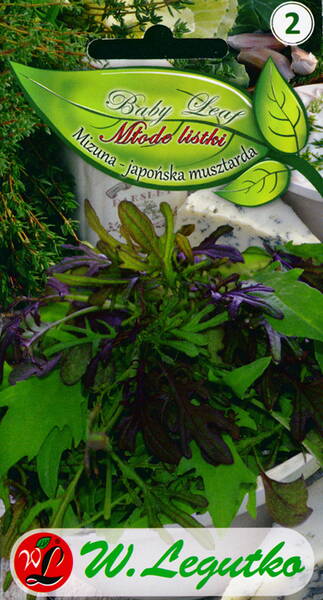Your shopping cart is empty!
Japanese sheet cabbage "Mizuna" (Japanese green salad Xiu Cai, japanese mustard)
Japanese mustard Mizuna or Japanese leafy cabbage (Brassica rapa nipponica) - easy grow japanese leaf vegetable.
A worthy competitor to spinach in salads.
Slim white leaf stalks and dark green leaves can be harvested in any size.
They are juicy, aromatic and suitable for fresh use and frying as well. Plant regrow after harvest.
Ultra-ripe, highly productive, salad vegetable crop, for growing in open and protected ground.
Strongly dissected, dark green leaves form a large rosette of leaves (30-40 pcs.).
The taste is excellent. It grows superbly after cutting, which makes it possible to get a harvest throughout the summer-autumn period. Intended for fresh consumption in salads and freezing.
1,0 g = 500 seeds.
Agricultural technology: good predecessors - legumes, cucumber, potatoes. You cannot grow cabbage after cabbage and other vegetable crops of the same family - radish, turnip, radish, turnip, turnip, watercress.
The optimum reaction of the soil medium is pH 6.5-7.2.
Japanese cabbage is a real exotic, it is the most little-known among cabbages. It is grown mainly in Japan and on the Pacific coast of China.
In terms of its biochemical composition, it differs little from Peking and Chinese cabbage (while it is in Japanese cabbage that the least mustard oils are contained, which give cabbage plants a specific taste and aroma).
This cabbage grows a little slower than Peking and Chinese cabbage. Since the leaves contain less mustard oils than Chinese cabbage and Chinese cabbage, Japanese cabbage is even more beneficial for cardiovascular diseases and stomach ulcers.
Japanese cabbage is consumed mainly fresh: salads, sandwiches, decorating dishes as an addition to a side dish.
A worthy competitor to spinach in salads.
Slim white leaf stalks and dark green leaves can be harvested in any size.
They are juicy, aromatic and suitable for fresh use and frying as well. Plant regrow after harvest.
Ultra-ripe, highly productive, salad vegetable crop, for growing in open and protected ground.
Strongly dissected, dark green leaves form a large rosette of leaves (30-40 pcs.).
The taste is excellent. It grows superbly after cutting, which makes it possible to get a harvest throughout the summer-autumn period. Intended for fresh consumption in salads and freezing.
1,0 g = 500 seeds.
Agricultural technology: good predecessors - legumes, cucumber, potatoes. You cannot grow cabbage after cabbage and other vegetable crops of the same family - radish, turnip, radish, turnip, turnip, watercress.
The optimum reaction of the soil medium is pH 6.5-7.2.
Japanese cabbage is a real exotic, it is the most little-known among cabbages. It is grown mainly in Japan and on the Pacific coast of China.
In terms of its biochemical composition, it differs little from Peking and Chinese cabbage (while it is in Japanese cabbage that the least mustard oils are contained, which give cabbage plants a specific taste and aroma).
This cabbage grows a little slower than Peking and Chinese cabbage. Since the leaves contain less mustard oils than Chinese cabbage and Chinese cabbage, Japanese cabbage is even more beneficial for cardiovascular diseases and stomach ulcers.
Japanese cabbage is consumed mainly fresh: salads, sandwiches, decorating dishes as an addition to a side dish.
Japanese leafy cabbage, Japanese green salad Xiu Cai. Bot. syn.: Brassica rapa ssp. nipposinica var. laciniata, Brassica rapa var. lancinifolia.












